This site is made possible by its sponsors.
Please visit them!
The heading above is a rebus.
B ![]()
![]() p
p ![]() a
a![]() g
g![]() e
e![]() s
s![]()
![]() a
a![]() r
r ![]() e
e ![]()
![]() d
d![]() e
e![]() d
d![]() i
i![]() c
c![]() a
a![]() t
t![]() e
e![]() d
d ![]()
![]() t
t![]() o
o
J![]() e
e![]() f
f![]() f
f ![]()
![]() B
B![]() i
i![]() l
l![]() l
l![]() i
i![]() n
n![]() g
g![]() s
s
beader - A punch with a hollow end used in chasing to leave dotted impressions on metal surfaces.
beam - A lintel. See post and lintel, ridgepole, and trabeation.
bearings - In heraldry, graphic symbols and mottoes on a field.
bearing wall - In architecture, any wall that holds up the weight of a structure. This describes all walls in history until the development at the end of the nineteenth century of the nonsupporting curtain wall.
beauty parlor or beauty salon - An establishment providing women with services that include hair cutting, washing, coloring, and shaping, and often manicures, pedicures, and facials as well.
Also see aesthetician and cosmetic.
beaux-arts - The high arts. French.
(pr. bo-ZAHR or bo-ZART)
bed - The surface on a printing press that establishes the maximum usable sheet size.
beehive tomb - A bee-hive-shaped type of subterranean tomb constructed as a corbel vault and found at pre-Archaic Greek sites.
Also see archaic, dromos, and Greek art.
beeswax - Wax from honeycombs, used as a medium in modeling, in encaustic painting, in wax varnishes, in etching grounds, as a resist in batik, and other techniques and media.
belvedere - In architecture, an open-roofed story built to provide a scenic view. It may also be a summerhouse, which is roofed but open; a gazebo.
(pr. BEL-və-DEER)
A curious example:

Maurits Cornelis Escher (Dutch, 1898-1972),
Belvedere, 1958, lithograph,
8 1/4 x 11 5/8 inches (462 x 295 mm), National Gallery of Art,
Washington, DC. This belvedere has three stories, but its drawing
results in an optical illusion.
Escher has employed a hybrid of linear
perspective that produces a mixture of two possibilities.
Note how the pillars connect
the second to the third story.
ben-ben - A pyramidal stone; a fetish of the Egyptian god Re (also spelled Ra).
benchmarks - See standards.
benday - In printmaking, a process using screens of various dot patterns to mechanically produce shading effects. This process was invented by Benjamin Day (1839-1916). Roy Lichtenstein (American, 1923-1997) included benday as one of the elements in his paintings signifying Pop Art qualities.
Examples:

Roy Lichtenstein (American, 1923-1997), Vicki,
1964, enamel on steel, 42 x 42 inches,
Minneapolis Institute of Arts.

Roy Lichtenstein, The Melody Haunts my Reverie, 1965, oil on canvas,
Nationalgalerie, Berlin. See cartoon.

Roy Lichtenstein, Stepping Out, 1978, oil
and Magna on canvas,
86 x 70 inches (218.4 x 177.8 cm), Metropolitan Museum of Art,
NY.
The commercial use of benday has become more and more rare with the rise of digital imaging.
beni-e or beni-ye or benizuri-e or beni-zuri-ye - In Japanese art tradition, a two-color print in pink and green, with its dominant tone of rose-red derived from saffron. They typically produce a strong color vibration. And, the method of making such prints.
Also see complementary colors, nishiki-e and tan-e.
Benin - A people and former kingdom of western Africa. Benin artists of the sixteenth and seventeenth centuries realized a high level of quality in their lost-wax casting of bronze sculpture.
(pr. bə-NIN)
Also see African art, and cire perdue.
benzene or benzine - Benzene (also spelled benzine) is a toxic, flammable hydrocarbon used as a solvent, as a rubber cement thinner, and as a cleaning solution on photographs.
Also see toluene.

beret - A round, soft brimless tam (hat). It fits snugly, and is often worn angled to one side. It has long been a traditional mode of head-covering throughout Europe, and now other parts of the world. Men, women and children of all walks have worn it, and continue to, but it has been popularly associated with artists since the nineteenth century, to the extent that the stereotypical artist is depicted wearing a beret.
(pr. bə-RAY)
Artists wearing berets:

Rembrandt Harmensz. van Rijn (Dutch, 1606-1669),
Self-Portrait
with Beret and Gold Chain, 1630-1, oil
on wood panel,
69.7 x 57cm, Walker Art Gallery, Liverpool. See Dutch
art and self-portrait.

Paul Cézanne (French, 1839-1906),
Self-Portrait
in a Beret (Autoportrait au béret), 1898-1900,
oil on canvas,
Museum of Fine Arts, Boston. See Post-Impressionism
and Paul Cézanne.

Claude Monet (French, 1840-1926), Self-Portrait
with a Beret (Autoportrait de Claude Monet coiffe d'un béret),
1886, 56 x 46 cm, oil on canvas, private collection. See
Impressionism and Claude
Monet.
Also see costume, easel, and palette.
Berlin Secession - See secession
bestiary - A collection of allegories with descriptions of real or imagined animals. In the numerous bestiaries of the Middle Ages, along with some accurate observations of natural history, some common misconceptions were preserved as well. Several modern bestiaries have been published too.
(pr. BES-tee-AY-ree)
Examples:

English, "De scitali serpente; Of the snake called scitalis.
De anphivena; Of the anphivena (having two heads, one at each end).
De ydro; Of the ydrus" in The Aberdeen Bestiary, late 12th century, this page cited is folio 68 verso, the book is 302 x 210 mm; the text area is 185 x 110/115 mm, University of Aberdeen, Scotland. Its text is in Latin. Because each picture in this bestiary was given a background of burnished gold, it must have been commissioned by a very wealthy patron.

English, a page about snakes and dragons in The Bestiary of Anne Walshe, c. 1400-1425, Royal Library in Copenhagen, Denmark (Copenhagen Kongelige Bibliotek), Gl. kgl. Saml. 1633 4°. It has 117 illustrations on its 154 pages, about 76% of the total number of pages. Its text is Latin, and was long ago owned by a woman named Anne Walshe. Because this volume is devoid of gold, it seems to have been commisioned by a more frugal or a less wealthy patron than that of the Aberdeen Bestiary.
Also see animalia, equestrian art, equine art, frottage, and gyo, and gyotaku.
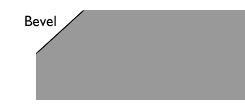 bevel - The meeting of a line
or surface with another at
any angle other than 90°,
or the angle at which they meet. Also, carving
or cutting to make a
bevel - The meeting of a line
or surface with another at
any angle other than 90°,
or the angle at which they meet. Also, carving
or cutting to make a  bevel; a chamfer.
It may also be an instrument which is formed by joining
two rules as adjustable arms in order to measure
or draw angles of any size or to
fix a surface at an angle; an instrument also known as a sliding
bevel or bevel square.
bevel; a chamfer.
It may also be an instrument which is formed by joining
two rules as adjustable arms in order to measure
or draw angles of any size or to
fix a surface at an angle; an instrument also known as a sliding
bevel or bevel square.
Also see bezel, dado, jewelry, molding, oblique, ogee, profile, splay, and tools.
bezel - A bevel on the edge of a cutting tool, such as a chisel. Or, a thin wall or rim of metal that anchors a gemstone in place.
Also see jewelry.
bhakti - In Buddhism, the devout, selfless direction of all tasks and activities of life to the service of one god; the adoration of a personalized deity.
(pr. bə-HOK-tee)
bias - A line diagonal to the grain of a fabric — at a 45° angle (half way between vertical and horizontal) to the selvage often utilized in the cutting, folding, or arranging of fabric. In another sense, bias can be a preference or inclination of temperament or attitude, especially one that inhibits impartial judgment. This sometimes qualifies as a prejudice or an instance of it, and is sometimes described as the coloring of an opinion or point of view. In statistics, this can be a sampling or testing error caused by systematically favoring some outcomes over others.
Also see align, analysis, appearance, art criticism, artistic temperament, assessment, buckskin ceiling, communicate, critique, direction, eccentric, empathy, enthusiasm, expression, interpretation, lookism, memory, motivation, oblique, obsession, positive, protractor, praise, research, sentiment, stereotype, straight, xenophilia, and xenophobia.
bibelot - A small art object, which is either rare or decorative. Also, a miniature book, especially one finely made.
(pr. BEE-bə-LO)
Also see bric-a-brac, confection, and gewgaw.
Biedermeier - A style of painting, furniture, and other crafts, prominent in Germany and Austria from 1815 to 1848, popular especially among the middle classes. It was a simplified adaptation of the French Empire style, which preceded it. The name is derived from two fictional bourgeois characters, Biedermann and Bummelmeier, in the satirical verses of Ludwig Eichrodt.
(pr. BEE-dr-MY-r)
bilateral - Refers to two sides.
Also see balance, lateral, laterality, symmetry, and asymmetry.
billboard - A large outdoor sign or advertisement.
Examples:
Chiat/Day, Nike outdoor billboard for LA Olympics, 1984.
Arnold Communications, Inc., Volkswagen New Beetle billboard, 1998.
Also see advertising, graphic design, and signage.
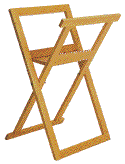
bin - A container that holds and displays a number of two-dimensional works of art. It is sometimes referred to as a cradle or a browser. Each work rests upright upon its lowest edge, leaning forward or back against flat, rigid supports. The bin is open at its top, allowing a viewer to flip through the works. Although not an optimal method of exhibiting artwork, bins are often used in galleries as an economical way to present art for sale. In artists' studios and collectors' homes, bins can provide accessible storage for accumulations of 2-D works. Since works placed in bins are typically unframed (abrasion could be a problem), it is wise to works placed in bins in some way from light, dirt, and other hazards. Enclosing each in a polypropylene sleeve and a rigid, acid-free cardboard backing can provide such protection.
Example:
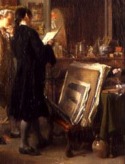
Jean-Louis-Ernest Meissonier (French, 1815-1891),
An Artist showing his Work (Les amateurs de dessin),
before 1850, oak panel, 38.4 x 29.1
x 0.3 cm, Wallace Collection, London. In his studio, an artist shows drawings or prints he has been storing
in a bin.
Also see collection, connoisseur, flat file, portfolio, solander box, stack tray, and storeroom.
binary colors - Colors made by the mixing of two hues. Examples are orange, green, and purple.
binder - The ingredient in the vehicle of a paint which adheres the pigment particles to one another and to the ground. It creates uniform consistency, solidity, and cohesion.
Also see adhesive, adobe, mortar and pestle, polymer clay, and solvent.
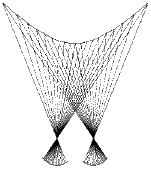
binocular vision - Seeing with two eyes simultaneously gives the viewer the ability to perceive depth. Stereoscopic images depend on the use of binocular vision.
Also see lens.

biomorphic form - An abstract form whose shapes are more organic than geometric, more curvaceous than linear. Much of the work of Hans [Jean] Arp (German-French, 1887-1966) was composed as biomorphic forms.
Other examples:

Frederick Kiesler (Austrian, 1896-1966),
Nesting Coffee Table, 1935-38, cast
aluminum, each 9 1/2 x 34 x 25
inches (24.1 x 86.4 x 63.5 cm) and 9 1/2 x 22 x 16 1/4 inches
(24 x 55.9 x 41.3 cm), Museum of Modern Art, NY.
Jean [or Hans] Arp (French, born Germany (Alsace), 1886-1966), Human Concretion, 1935, plaster, 19 1/2 x 18 3/4 x 25 1/2 inches (49.5 x 47.6 x 64.7 cm), Museum of Modern Art, NY. See Dada.

Isamu Noguchi (American, 1904-1988), Kouros, 1944-45, marble,
height 9 feet 9 inches (297.2
cm); base: 34 1/8 x 42 inches (86.7 x 106.7 cm), Metropolitan
Museum of Art, NY. This figurative
and biomorphic modern sculpture has
abstracted the human figure
into fragmented, bonelike elements.
Also see amorphous, concretion, and regular.
bird's-eye view - Seeing from a point of view from an altitude or from a distance; a comprehensive view in a downward direction; also called an aerial view. A variation on landscape, the horizon for a bird's-eye view is usually placed very high in the picture, or outside of it completely. Sometimes called a bird's-eye survey.
Examples:
Japan, The Battles of Hogen and Heiji, Edo period (1615-1868), 17th century, pair of six-panel folding screens, ink, color, and gold leaf on paper, each 60 15/16 x 11 ft 8 inches (154.8 x 355.6 cm), Metropolitan Museum of Art, NY. See Japanese art and panorama.
Bird's-eye views of Chicago in 1820, 1854, 1857, 1871, and 1893. Also see 1996 aerial photographs of Chicago by Alex S. MacLean.

F.L. Hoppin (American), Bird's-eye view of general plan of a proposal
for the park system of the District of Columbia, from
point taken 4,000 feet above Arlington, 1902. Hoppin was following
directions given to him by the members of the U.S. Senate Park
Commission, whose members were: Augustus Saint-Gaudens (American
sculptor, 1848-1907), Daniel Hudson Burnham (American architect,
1846-1912), Frederick Law Olmsted, Jr. (American landscape architect,
1822-1903), and Charles Follen McKim (American architect, 1847-1909).

Stauth & Simpson, Birds Eye View of Waco Tex 9/13/17, 1917, panorama photograph, 7 1/2 x 37 inches, Michael Delahunt collection. Although this picture was produced as one continuous shot, the image posted here is pieced from scans of four parts of the photo. On May 15, 1916, 16 months before this photo was taken, the lawn we see beside City Hall — the imposing building nearby and to the right of center — was the site of the burning and lynching of an African American named Jesse Washington, witnessed by some 15,000 people — about half of Waco’s population at the time. Waco's mayor and police chief watched the lynching from City Hall's second story windows, and did not intervene. The building was torn down years later, and since 1972, its site has been occupied by the Waco Convention Center and a Hilton Hotel. Baylor University is four blocks away. There is a memorial marker in Waco to the 114 people who died in a 1953 tornado; there's another memorial to the 80 people killed in 1993 at the Branch Davidian compound near Waco, and there is a Dr. Pepper Museum memorializing the Waco drugstore where the drink was invented in 1885. There is no memorial to Mr. Washington.
Internet resource concerned with bird's-eye view:
Also see aerial perspective, di sotto in sù, ephemera, fish-eye lens, panorama, perspective, point of view, wide-angle, and worm's-eye view.
biscuit - Clay that has been fired once but not glazed. In this sense, also called bisque.
bisque - Clay that has been fired once but not glazed. Also called biscuit.
Example:
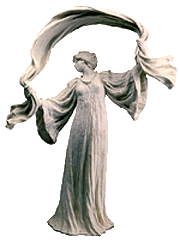
Agathon Léonard (French, 1841-1923)
for Sèvres, Royal Porcelain Factory, Dancing Figure from the Table Centrepiece 'Dance
with Scarves', 1900, bisque porcelain, height
47.5 cm, Hermitage Museum, St. Petersburg, Russia. This Art Nouveau figure is one of fourteen in a set of female
figures dancing and playing music.
See drapery.
bit-depth - See dynamic range.
bite - May refer either to the action of a mordant in etching or to the tooth of paper.
Also see bitten in.
bit-mapped image or bitmap image - A digital image generated by a series of bits and bytes, resulting in an image displayed as a grid of pixels, each a specific color and gray scale value. Most images on the Web are bitmaps — typically JPEGs and GIFs. Also known as a raster image. The alternative sort of image is a vector graphic.
Related link:
Also see aliased and anti-aliased.
bitten in - Etched with acid. See etching.
bitumen - A tarry substance formerly used as an oil
color, now obsolete because of
its tendency to crack and darken.
https://inform.quest/_art